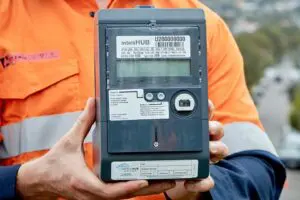Is there a case in economics for neighbourhood batteries to pay discounted charges for their network usage when they draw electricity from the grid?
In other words, is it economically sensible to ask consumers to subsidise the network bill for community batteries? In a working paper we are releasing today we examine this and we conclude yes. Conditionally.
Australia’s regulatory agencies have different views on whether small batteries (less than 5 MW) should pay network charges when they withdraw electricity from the grid.
The Australian Energy Market Operator says small batteries should be treated in the same way as auxiliary load of generators – i.e. no network charges should apply.
The Australian Energy Regulator on the other hand thinks that full use of system charges should apply in the usual way to all batteries. The Australian Energy Markets Commission is undecided and suggests a review. None of these agencies presents economic analysis to support their views.
Rather, they assert statements of principle to defend their perspectives (for AEMO this is that batteries should be treated in the same way as generators and for the AER it is that batteries should be treated in the same way as load).
Feasibility studies have been undertaken by KPMG (for a distributor developing neighbourhood batteries in New South Wales) and by researchers at the ANU (for a neighbourhood battery in the ACT).
Both ANU and KPMG came to a similar conclusions on network usage of system charges for neighbourhood batteries: that LUoS tariffs should apply to the battery when withdrawing electricity from the grid and should also apply in the charges that consumers pay when they use electricity that is discharged from the battery back to the grid.
Both KPMG and ANU argue along similar lines: that the flows are mainly local and so local charges should apply and that if LUoS did not apply, neighbourhood batteries would not be financially viable.
In Britain, all storage (not just small batteries) are treated in the same way as generators when they withdraw electricity from the grid – and so are largely exempt from use of system charges. This is consistent with AEMO’s suggestion for the treatment of small batteries.
We reviewed the various neighbourhood batteries trials in Australia. Network charges seem to have received scant attention so far in these developments. This seems to be because in most cases the neighbourhood batteries are owned by regulated distributors.
In a proposed neighbourhood battery to be developed by Yarra Energy Foundation in partnership with Citipower, we understand the thinking is to fully discount network charges when the battery withdraws from the grid and also to partially discount network usage charges paid by consumers in respect of electricity that is supplied by the battery when it discharges back into the grid.
Our economic analysis starts with a brief focus on relevant theoretical aspects. There are two main points here:
- Firstly electricity networks are natural monopolies and so average cost is typically higher than marginal cost. This creates the opportunity to increase efficiency by charging marginal costs to some users if, for those users, charging them average costs would undermine efficient investment of forego efficient consumption. We draw on this later as part of the rationale for LUoS for neighbourhood batteries.
- Second in electricity circuits, electrical current follows the path of least resistance according to Kirchoff’s Current and Voltage laws. This means it is impossible to track the origin of the electricity drawn from a shared grid. This means that we can not know for certain whether a neighbourhood battery is being charged by locally produced solar. Likewise we can not know for certain that when a battery on the grid discharges to the grid, that that electricity is being consumed by one customer rather than another. In fact all we can say is that, depending on the location of the battery and local supply and demand, it is more or less likely that the battery is storing locally-produced electricity or that when it discharges it is being consumed locally.
In the economic analysis we raise and discuss the merits of various arguments for a LUoS.
We conclude that a plausible argument, in economics, can made for LUoS for neighbourhood batteries on the basis that if neighbourhood batteries are cheaper than behind-the-meter batteries and if charging full DUoS to neighbourhood batteries means that behind the meter batteries would developed, then discounting DUoS would ensure a cheaper solution and this would be increase efficiency.
But this argument does depend on being sure that a neighbourhood battery would not impose additional costs on the grid (i.e. that marginal costs are small) and that neighbourhood batteries are not so much cheaper than behind-the-meter batteries that neighbourhood batteries would be developed even if they were charged the full network use of system tariff.
Taking account of the conditional acceptance of LUoS, the details of the implementation of LUoS are important. We suggest, indicatively, that neighbourhood battery eligibility for LUoS should be subject to the following conditions:
- Neighbourhood batteries must be located in an area with high solar penetration (greater than, say, 20% of households within a 5 km radius);
- The Neighbourhood battery capacity must be smaller than the actual or reasonably expected simultaneous peak local surplus solar production with the 5 km radius); and
- Neighbourhood batteries must not be connected to networks above 11 kV.
We think the LUoS discount should apply to both consumption and demand charges and should only apply to electricity withdrawn from the grid between 10am and 3pm.
All of these conditions are justified on the basis of ensuring that, as far as possible, neighbourhood batteries store locally produced electricity and do not impose additional costs on the network. In this case discounting network charges to a neighbourhood battery has the prospect of stimulating efficiency.
Finally, LUoS discounts for neighbourhood batteries leads to the obvious question of why such discounts would not also apply for locally consumed solar: why does it matter that the locally produced solar is stored in a battery in order to be eligible to pay LUoS?
The answer to this is that the rationale for the LUoS discount is that it will improve efficiency by encouraging investment in supposedly lower cost solutions (neighbourhood batteries rather than behind-the-meter batteries).
Discounting use of system charges for locally consumed solar is unlikely to have this effect (because the price elasticity of demand is very low – very few consumers would buy more electricity if network charges were reduced).
In addition, as a matter of practical implementation, we think that LUoS for locally consumed solar will be very complex to implement.
However, though the economic rationale does not exist we suggest the “fairness” concern here merits a response.
An appropriate response would be the implementation of a “solar sponge” tariff that discounts DUoS for small consumers for electricity consumed when there is the greatest likelihood that it is being supplied by locally produced solar, say from 10am to 3pm.
This solar sponge tariff should be implemented in parallel with the implementation of LUoS for neighbourhood batteries.










